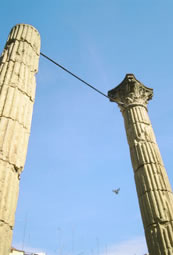
Rupestrian art of the Mediterranean Arch
In 1998, the selected committee which was in charge of appraising the candidatures that contended for being part of the list of the Unesco patrimonial goods, accepted the entry of the spaces which are integrated into the rupestrian art of the Mediterranean Arch. It is about the group of stronger cave paintings of Europe which offers an exceptional image about the evolution of the human culture. These paintings have an important meaning since they were produced in a critical phase of the human development, though the climatic change and the subsequent socioeconomic transformations of the Neolithic. They are unique in their style and subject matter.The rupestrian art of the Mediterranean Arch of the Iberian Peninsula includes more than 750 painting sites which are divided up by the autonomous communities of Catalonia, Valencia, Aragón, Murcia, Andalusia and Castilla-La Mancha, even though the senior part of them are located in the Valencian province of Castelló, where the presence of archaeological remains is stressed.
Regarding only the Catalan heritage that belongs to the set of world goods already named, it is necessary to note down that sixty of the Mediterranean found sites are situated in little deep shelters ans caves of the provinces of Barcelona, Lleida and Tarragona. Just thirty-nine of them are placed on the Tarragona & Costa Brava demarcation. Here we find the signs of Ulldecona, Montblanc and Tivissa, which are considered the most obvious cultural signs of the Spanish East settlers from the upper Paleolithic period until the protohistory - the annex contains a complete list of the most important shelters and caves of the area -.
In order to situate this heritage, it is necessary to go backwards to the period of 6.000 to the 1.000 bC., time in what the humans manifested their art in rocky shelters which were placed along the limited zone between the Iberian System ans the Penibetics Mountains. It was a schematic art, of flat inks and character or future intention. The most ancient paintings represent naturalistic scenes with animals, men ans scenes of hunting, while the most modern ones have a more symbolic character. In general, we can talk about a vital art, fully of interests and movement, with an elementary perspective which orders the figures according to its previous outlines.
The main artistic characteristic of this zone, with regard to the world-wide rupestrian art, is the coexistence of the Eastern rupestrian art with other types of non naturalistic paintings: schematic and macroschematic art, with art seasons of Paleolithic period. In many cases the different styles share the same shelters. The Eastern rupestrian art is a unique culture view of a postpaleolithic prehistoric society. The sets are located in open shelters and its representations, of naturalistic type, have the reproduction of scenes as the essential characteristic. In general they are representations of small and medium sclae where, besides the red, there is a white and yellow predominance. Chronologically they belong to the final Epipaleolithic period and the beginning of the Neolithic on the peninsular east.
It is necessary to highlight that the fragility of this art, regarding the support and the paintings, has supposed the closure of many of the sets, without possibilities of being visited by the general public. Many of them have a difficult conservation, which is in danger, or they are found in inaccessible zones. After calling the correspondins town councils, it is possible to visit the following heritage sites: the caves of the Ramat, those of the Cingle and those of the Pi in Tivissa, that of the Feixet in The Perelló and the shelters of Ermites I, II, IIIb, IV or Dark Cave, V, V exterior, VI, VII, VIII and X in Ulldecona.
Regarding the remains of Ulldecona, there are thirteen neolithic shelters that contain examples of rupestrian art, and they configure the most important representation of this art in Catalonia. The group is located in the southeast long cliff of the Godall mountain range, and they suggest several stylistic phases which reach the most classical Eastern art until the schematic and naturalist one. On the whole and according to the most ancient figures, they could be included in a preceramic moment – probably 6000 or 5000 years bC.-; while the most recent ones are representative of the Age of Bronze.
Approfondimenti
- Rupestrian art of the Mediterranean Arch
- Ancient Roman City of Tarragona
- Monastery of Poblet
|
FORUM
